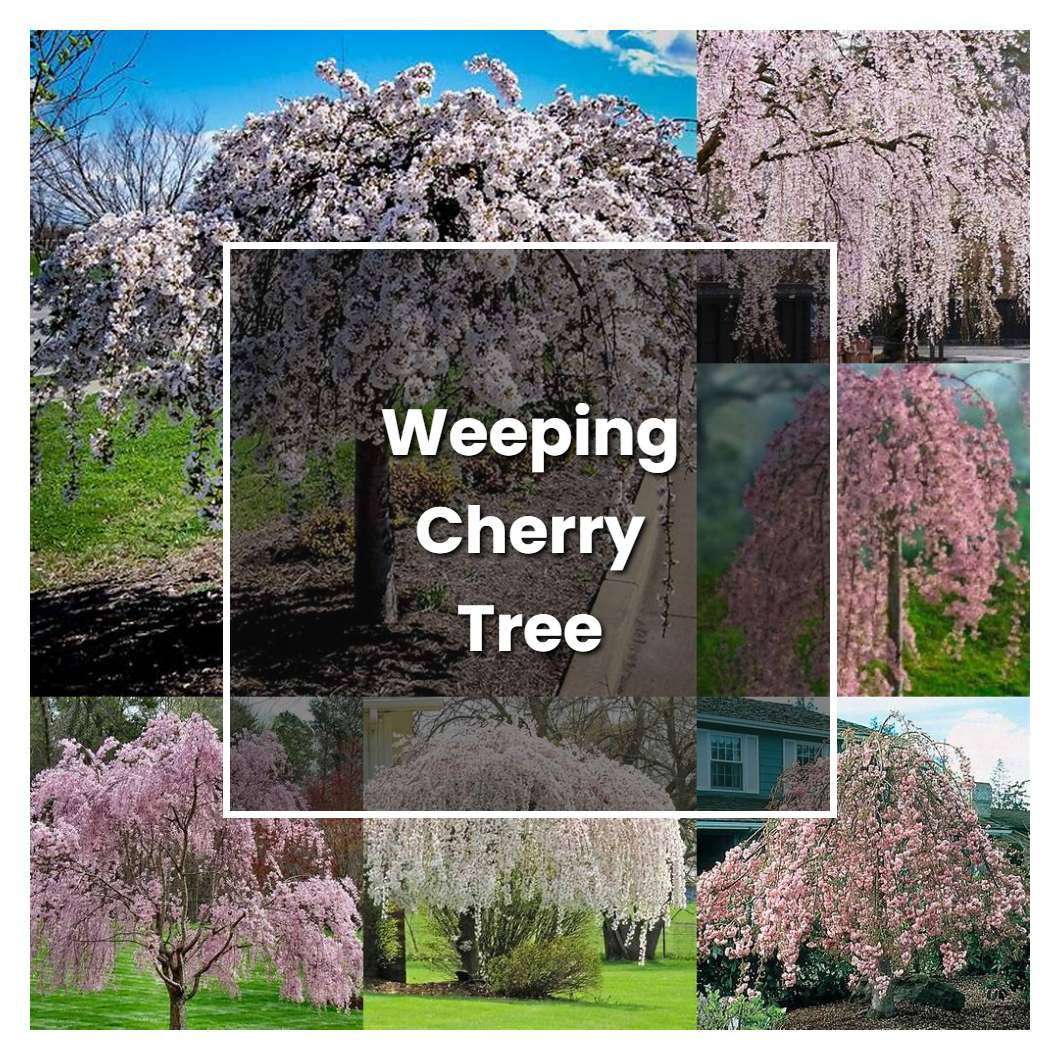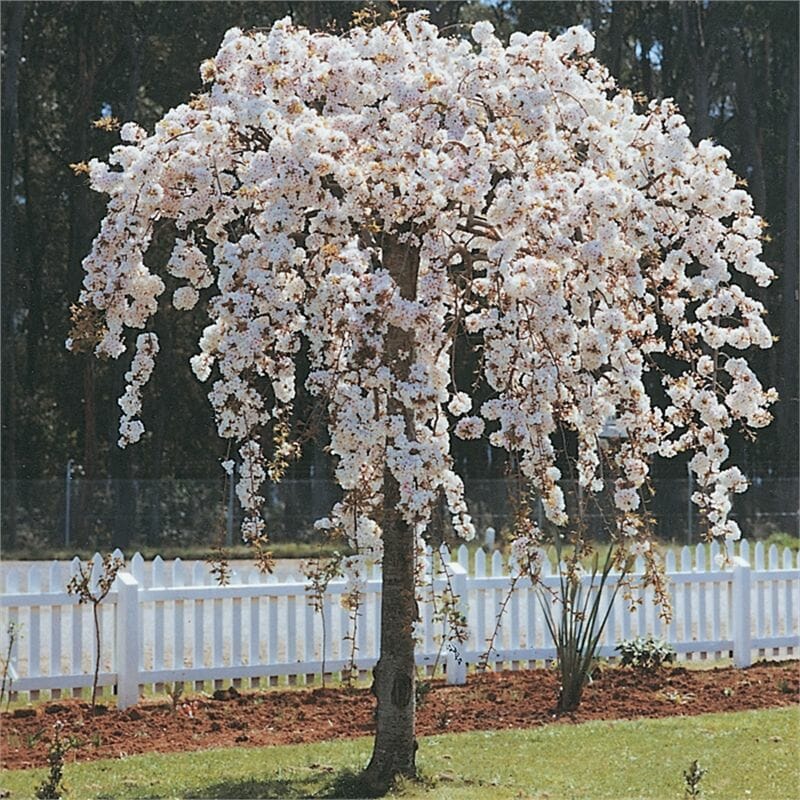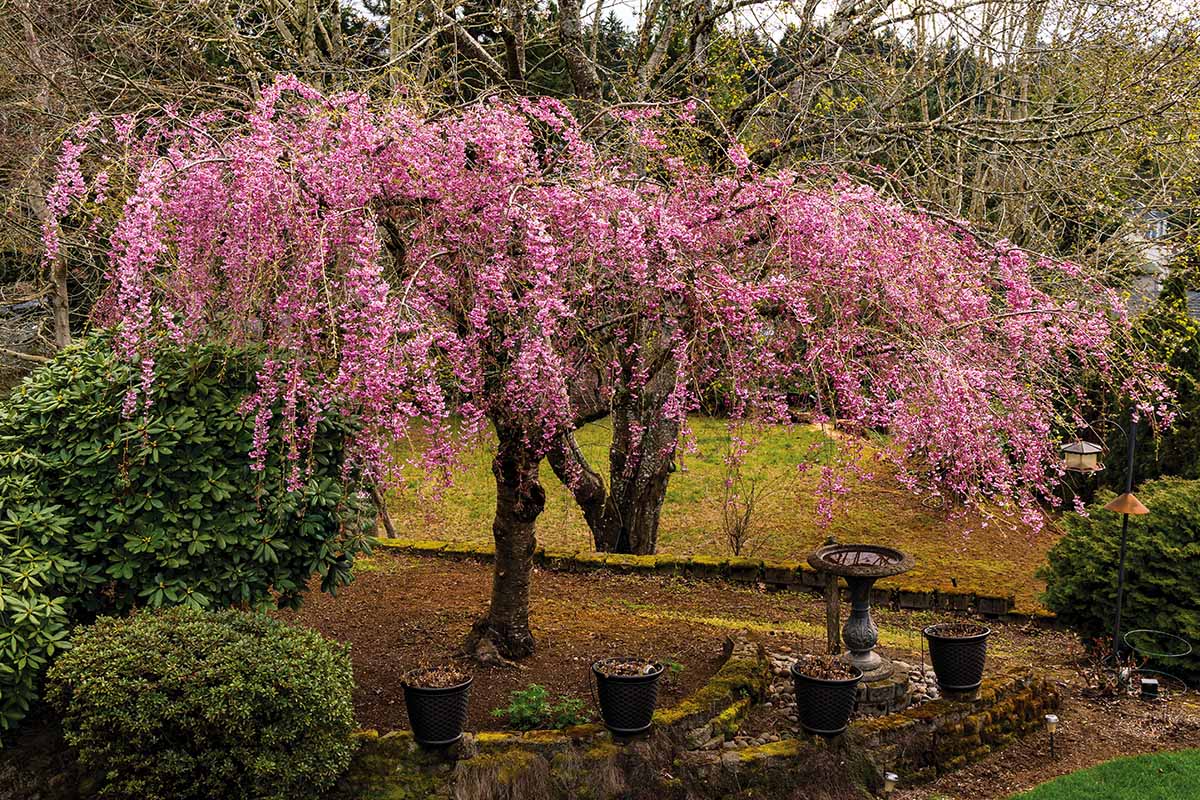Choosing the Perfect Weeping Cherry Tree Variety
When it comes to growing a weeping cherry tree, selecting the right variety is crucial for optimal growth and beauty. With several types of weeping cherry trees available, each with its unique characteristics, it’s essential to choose a variety that suits your climate, soil, and desired level of maintenance. Here are a few popular varieties to consider:
The ‘Pendula’ weeping cherry tree is a popular choice for its stunning, drooping branches and vibrant pink flowers. This variety is relatively small, growing up to 10 feet tall, making it an excellent option for smaller gardens or landscapes. ‘Pendula’ is also known for its hardiness, tolerating temperatures as low as -20°F (-29°C) and thriving in USDA zones 5-8.
Another popular variety is the ‘Shidare Sakura’, which boasts beautiful, weeping branches and delicate, pale pink flowers. This tree grows slightly larger than ‘Pendula’, reaching heights of up to 15 feet, and is suitable for USDA zones 5-9. ‘Shidare Sakura’ is also known for its stunning fall colors, with leaves turning shades of orange and red.
The ‘Weeping Higan’ cherry tree is a more compact variety, growing up to 6 feet tall, with a spread of around 8 feet. This tree is ideal for smaller spaces and produces beautiful, pale pink flowers in the spring. ‘Weeping Higan’ is hardy in USDA zones 5-8 and requires minimal maintenance.
When selecting a weeping cherry tree variety, consider factors such as growth habits, flower colors, and hardiness zones. By choosing the right variety for your specific climate and landscape, you’ll be well on your way to growing a stunning weeping cherry tree that will provide beauty and enjoyment for years to come.
How to Plant a Weeping Cherry Tree for Optimal Growth
Planting a weeping cherry tree requires careful consideration to ensure optimal growth and development. By following these steps, you can give your tree the best possible start and enjoy its beauty for years to come.
Step 1: Select the Right Location
When growing a weeping cherry tree, it’s essential to choose a location that provides full sun to partial shade. Weeping cherry trees prefer well-draining soil and a slightly acidic pH between 6.0 and 6.5. Avoid planting in low-lying areas where water may collect, as this can lead to root rot and other problems.
Step 2: Prepare the Soil
Before planting, prepare the soil by digging a hole that is twice as wide and just as deep as the tree’s root ball. Add a 2-inch layer of organic matter such as compost or well-rotted manure to improve soil fertility and drainage. Mix the organic matter into the soil, taking care not to damage the tree’s roots.
Step 3: Plant the Tree
Gently remove the tree from its container or burlap, taking care not to disturb the roots. Place the tree in the hole, making sure the root flare (where the trunk flares out at the base of the tree) is level with the soil surface. Fill the hole with soil, tamping it down gently as you go to remove any air pockets. Water the tree thoroughly to settle the soil.
Step 4: Water and Mulch
Water your weeping cherry tree regularly, especially during its first year of growth. Aim to provide about 1 inch of water per week, either through rainfall or irrigation. Mulch around the base of the tree to retain moisture, suppress weeds, and regulate soil temperature. Keep the mulch layer thin (about 2-3 inches) and avoid piling it against the trunk.
By following these steps, you can give your weeping cherry tree the best possible start and enjoy its beauty for years to come. Remember to provide regular care and maintenance, including pruning, fertilization, and pest management, to promote healthy growth and prevent common problems.
Essential Care Tips for Weeping Cherry Trees
Regular maintenance is crucial for promoting healthy growth and preventing common problems when growing a weeping cherry tree. By following these essential care tips, you can ensure your tree thrives and provides beauty and enjoyment for years to come.
Pruning: Pruning is a critical aspect of weeping cherry tree care. Prune your tree annually to maintain its shape, promote healthy growth, and encourage fruiting. Remove any dead, diseased, or damaged branches, and thin out the canopy to allow sunlight to reach the fruiting branches.
Fertilization: Weeping cherry trees benefit from regular fertilization. Feed your tree with a balanced, slow-release fertilizer in early spring, following the manufacturer’s instructions. Avoid over-fertilizing, as this can damage the tree’s roots and lead to nutrient deficiencies.
Pest Management: Weeping cherry trees are susceptible to pests such as aphids, spider mites, and scale. Monitor your tree regularly for signs of infestation, and treat promptly with insecticidal soap or neem oil. Practice good hygiene by removing any infested branches and disposing of them properly.
Disease Prevention: Weeping cherry trees are also prone to diseases such as powdery mildew and black knot. Practice good sanitation by removing any infected branches, and treat with fungicides as needed. Water your tree carefully, avoiding overhead irrigation, which can spread disease.
Mulching: Mulching around the base of your weeping cherry tree helps retain moisture, suppress weeds, and regulate soil temperature. Use a thin layer (about 2-3 inches) of organic mulch such as wood chips or bark, keeping it away from the trunk to prevent rot.
By following these essential care tips, you can promote healthy growth, prevent common problems, and enjoy the beauty of your weeping cherry tree for years to come. Remember to monitor your tree regularly and adjust your care routine as needed to ensure optimal growth and development.
Pruning Techniques for a Beautiful Weeping Cherry Tree Shape
Pruning is a crucial aspect of maintaining the weeping shape of a weeping cherry tree. By pruning your tree regularly, you can promote healthy growth, encourage fruiting, and maintain the tree’s unique shape. Here are some pruning techniques to help you achieve a beautiful weeping cherry tree shape:
Removing Dead or Diseased Branches: Regularly inspect your tree for dead or diseased branches, and remove them promptly. This will help prevent the spread of disease and encourage healthy growth. Use clean, sharp pruning tools to make cuts just above a growth node, and remove any weak or damaged branches.
Thinning Out the Canopy: Weeping cherry trees can become dense and overcrowded, which can lead to reduced fruiting and increased disease susceptibility. Thin out the canopy by removing select branches to allow sunlight to reach the fruiting branches. This will also help maintain air circulation and promote healthy growth.
Shaping the Tree’s Overall Form: Weeping cherry trees are known for their unique, weeping shape. To maintain this shape, prune your tree regularly to encourage a central leader and a balanced, symmetrical shape. Remove any branches that are growing outside of the tree’s natural shape, and thin out the canopy to maintain a balanced, open shape.
Pruning for Fruit Production: Weeping cherry trees are also grown for their fruit, which can be a delicious and nutritious addition to your diet. To promote fruit production, prune your tree to encourage a strong, central leader and a balanced, open shape. Remove any weak or damaged branches, and thin out the canopy to allow sunlight to reach the fruiting branches.
By following these pruning techniques, you can maintain the beautiful weeping shape of your weeping cherry tree and promote healthy growth, fruit production, and overall tree health. Remember to prune your tree regularly, and always use clean, sharp pruning tools to make cuts just above a growth node.
Common Problems and Solutions for Weeping Cherry Trees
Despite their beauty and charm, weeping cherry trees can be susceptible to various problems, including disease, pests, and nutrient deficiencies. By understanding these common issues and taking steps to address them, you can help ensure the health and well-being of your weeping cherry tree.
Disease: Weeping cherry trees are prone to diseases such as powdery mildew, black knot, and leaf spot. To prevent these diseases, maintain good sanitation practices, such as removing any infected branches and disposing of them properly. Regularly inspect your tree for signs of disease, and treat promptly with fungicides if necessary.
Pests: Weeping cherry trees can be susceptible to pests such as aphids, spider mites, and scale. Monitor your tree regularly for signs of infestation, and treat promptly with insecticidal soap or neem oil. Practice good hygiene by removing any infested branches and disposing of them properly.
Nutrient Deficiencies: Weeping cherry trees require a balanced diet of nutrients to thrive. Regularly fertilize your tree with a balanced, slow-release fertilizer, following the manufacturer’s instructions. Soil testing can help identify any nutrient deficiencies, allowing you to take corrective action.
Root Damage: Weeping cherry trees can be susceptible to root damage, particularly if the soil is poorly draining or if the tree is planted too deeply. To prevent root damage, plant your tree in well-draining soil and avoid planting too deeply. Regularly inspect your tree for signs of root damage, and take corrective action if necessary.
By understanding these common problems and taking steps to address them, you can help ensure the health and well-being of your weeping cherry tree. Remember to regularly inspect your tree for signs of disease, pests, and nutrient deficiencies, and take prompt action if necessary.
Training and Supporting Weeping Cherry Tree Branches
Training and supporting the branches of a weeping cherry tree is essential for maintaining its shape and promoting healthy growth. By providing the right support, you can encourage your tree to grow in a way that showcases its beautiful, weeping branches.
Using Stakes: Stakes are a common method for supporting weeping cherry tree branches. Drive a stake into the ground near the base of the tree, and tie the branch to the stake using a soft material like twine or cloth. This will help keep the branch from breaking or becoming damaged.
Using Trellises: Trellises are another option for supporting weeping cherry tree branches. Install a trellis near the base of the tree, and train the branches to grow up the trellis. This will help keep the branches from becoming too long or unruly.
Using Other Support Systems: In addition to stakes and trellises, there are other support systems you can use to train and support your weeping cherry tree branches. For example, you can use a espalier system, which involves training the branches to grow along a wall or other flat surface.
Benefits of Training and Supporting: Training and supporting your weeping cherry tree branches can have several benefits. For one, it can help maintain the tree’s shape and promote healthy growth. It can also help prevent damage to the branches, which can be prone to breaking or becoming damaged.
Timing is Everything: When it comes to training and supporting your weeping cherry tree branches, timing is everything. It’s best to start training your tree when it’s young, as this will help it develop a strong, healthy shape. You can also prune your tree regularly to maintain its shape and promote healthy growth.
Propagation Methods for Weeping Cherry Trees
Propagation is an essential step in growing a weeping cherry tree, as it allows you to reproduce the tree and share it with others. There are several methods for propagating weeping cherry trees, each with its own advantages and disadvantages.
Grafting: Grafting is a popular method for propagating weeping cherry trees. This involves joining a piece of a stem (called a scion) from one tree to the root system of another tree (called a rootstock). Grafting allows you to combine the desirable traits of two trees, such as the beautiful flowers of one tree with the strong root system of another.
Budding: Budding is another method for propagating weeping cherry trees. This involves joining a single bud from one tree to the root system of another tree. Budding is similar to grafting, but it involves only a single bud rather than a piece of a stem.
Seed Propagation: Seed propagation is a more traditional method for propagating weeping cherry trees. This involves planting seeds from a mature tree in a nursery or garden bed. Seed propagation can be a slower process than grafting or budding, but it allows you to produce a large number of trees at a lower cost.
Advantages and Disadvantages: Each propagation method has its own advantages and disadvantages. Grafting and budding allow you to combine the desirable traits of two trees, but they can be more expensive and time-consuming than seed propagation. Seed propagation is a more traditional method, but it can be slower and less reliable than grafting or budding.
Choosing the Right Method: The right propagation method for you will depend on your goals and resources. If you want to produce a large number of trees quickly and efficiently, seed propagation may be the best option. If you want to combine the desirable traits of two trees, grafting or budding may be a better choice.
Enjoying the Beauty of Your Weeping Cherry Tree
One of the greatest joys of growing a weeping cherry tree is the opportunity to appreciate its beauty throughout the seasons. From the stunning flowers in the spring to the attractive foliage in the summer and the vibrant colors in the fall, a weeping cherry tree is a true delight to behold.
Spring: In the spring, a weeping cherry tree is a sight to behold. The stunning flowers, which range in color from pale pink to deep purple, are a true delight to behold. The flowers are also highly fragrant, filling the air with a sweet, floral scent.
Summer: In the summer, a weeping cherry tree provides a beautiful canopy of shade, perfect for picnics, barbecues, or simply relaxing in the garden. The attractive foliage, which ranges in color from deep green to bronze, is also a true delight to behold.
Fall: In the fall, a weeping cherry tree is a true spectacle. The vibrant colors, which range from golden yellow to deep orange, are a true delight to behold. The tree also produces small, edible fruits, which are a favorite of birds and other wildlife.
Winter: In the winter, a weeping cherry tree takes on a serene, peaceful quality. The bare branches, which are often adorned with snow or ice, are a true delight to behold. The tree also provides a beautiful backdrop for winter flowers, such as snowdrops or winter aconite.
Tips for Enjoying Your Weeping Cherry Tree: To fully appreciate the beauty of your weeping cherry tree, here are a few tips:
Take a walk around your tree regularly to appreciate its beauty from different angles.
Plant flowers or shrubs around the base of your tree to create a beautiful, colorful display.
Use outdoor lighting to highlight the beauty of your tree at night.
Take photos of your tree throughout the seasons to capture its beauty and create lasting memories.







:max_bytes(150000):strip_icc()/weeping-cherry-light-pink-big-5a2d63899802070037117b92.jpg)

